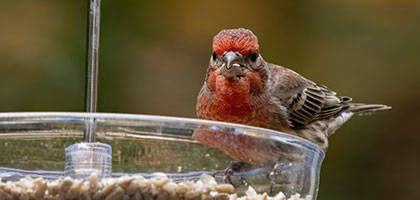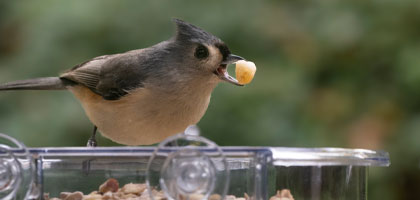Cardinals are a delight to watch. Their vibrant red plumage and melodic songs make them a favorite among bird enthusiasts.
But how do you attract these beautiful birds to your backyard? The answer lies in understanding their dietary preferences.
This guide will reveal the top 5 foods cardinals love. It will also provide practical tips on how to serve these foods effectively.
Whether you're a seasoned bird watcher or a homeowner looking to create a cardinal-friendly environment, this guide is for you.
So, let's dive in and explore the world of feeding cardinals. Your backyard could soon be a haven for these stunning birds.
1. Black Oil Sunflower Seeds: A Cardinal Favorite
Black oil sunflower seeds are a top pick for cardinals. Their thin shells make them easy to crack open, suiting the cardinals' strong beaks.
These seeds are packed with essential nutrients like protein and fat, offering energy and health benefits. This makes them the best cardinal bird food for attracting these birds.
To serve sunflower seeds, use hopper or platform feeders. These feeder types offer plenty of perching space, accommodating multiple cardinals at a time.
Fill the feeder regularly to keep cardinals returning. Consistency is crucial in feeding cardinals, as they are creatures of habit.
Consider these points when choosing sunflower seeds:
- Black oil variety is best due to thinner shells.
- Provide a squirrel proof feeder to keep seeds safe.
- Clean the feeder often to avoid spoilage and disease.
2. Safflower Seeds: The Squirrel-Resistant Option
Safflower seeds are a great choice for feeding cardinals. These seeds have a bitter taste that tends to deter squirrels and raccoons, making them less likely to raid your feeders. This characteristic gives them an edge over other seeds when trying to attract cardinals specifically.
Cardinals have a strong preference for safflower seeds, despite the bland flavor. These seeds provide the necessary nutrients like healthy fats, vital for the cardinals’ wellbeing. Therefore, safflower seeds can be considered some of the best bird food options for feeders.
When serving safflower seeds, start by introducing small amounts. Mix them initially with other seeds and mixes to help cardinals become accustomed. Once they get familiar, you can transition to providing safflower seeds alone.
Choose a feeder that accommodates the cardinals’ feeding style. Platform feeders are ideal since they allow easy access while minimizing mess. A large bird feeder is also suitable, offering multiple cardinals enough space to feed comfortably.
Consider these tips to optimize safflower seed feeding:
- Mix with other seeds at first for better acceptance.
- Use a platform feeder to reduce seed waste.
- Protect the feeder with a squirrel proof design.
3. Shelled Peanuts: High-Energy Treats
Shelled peanuts are a fantastic food choice for cardinals. They offer a rich source of energy through their high protein and fat content. This is especially beneficial during winter when cardinals need more calories to maintain body heat and energy levels.
Offering peanuts to cardinals can be simple. Crush or break whole peanuts into smaller pieces to make them easier to handle. Sprinkle these pieces on a platform feeder where cardinals can easily access them. You can also mix them with other seeds to create a diverse feeding mix.
Choosing the right peanut feeder is crucial for success. A peanut feeder designed with small openings will prevent larger wildlife from stealing the peanuts. Look for a feeder that allows cardinals to perch comfortably, giving them easy access to the peanuts.
Remember these points when serving peanuts:
- Crush whole peanuts for easier consumption.
- Use a peanut feeder with small openings.
- Mix with other seeds for variety.
4. Mealworms: Protein-Packed Snacks
Mealworms are an excellent protein source for cardinals. They mimic the insects cardinals naturally hunt, providing essential nutrients. Incorporating mealworms into your feeding routine can attract more cardinals to your backyard, especially during breeding season when extra protein is important.
Serving mealworms to cardinals can be straightforward. Offer them dried or live, depending on your preference. Scatter a small handful on a flat surface or mix them with seeds to encourage cardinals to try them.
For optimal results, consider investing in a mealworm feeder. This type of feeder is designed to keep mealworms contained while allowing easy access for cardinals. It also minimizes wastage and prevents non-target animals from accessing the food.
Here are some tips for serving mealworms:
- Offer both dried and live mealworms for variety.
- Place mealworms on a flat surface or mix with seeds.
- Use a mealworm feeder to keep them secure.
5. Fresh Fruit and Berries: Natural Sweetness
Cardinals have a natural fondness for fresh fruit and berries. They enjoy apple slices, grapes, blueberries, and raspberries. Fruits not only add variety to their diet but also provide hydration.
To serve fresh fruit to cardinals, cut the fruit into manageable pieces. Place the fruit on platform feeders or scatter it on the ground. This approach mimics how cardinals forage in nature.
When offering fruit, follow safe practices to ensure cardinals' health. Always wash fruits thoroughly to remove any pesticides. Avoid offering fruit that is overripe or moldy.
Here are some tips for serving fruit:
- Use fruits like apples, grapes, and berries.
- Cut fruit into small, manageable pieces.
- Wash fruits thoroughly before serving.
- Rotate fruits to ensure freshness and variety.
Including fresh fruit in your feeding regime can attract a colorful array of cardinals and help support their diverse dietary needs.
Creating a Cardinal-Friendly Environment
The location of your bird feeders plays a vital role in attracting cardinals. Position feeders near shrubs or trees to give them a sense of security. This setup mimics their natural habitat and encourages regular visits.
Beyond food, water sources are crucial for cardinals. Providing a clean birdbath can make your yard more inviting. Ensure the birdbath is shallow and cleaned regularly to attract cardinals safely.
Consider planting native vegetation to support cardinals naturally. Native plants can offer shelter and additional food sources like berries. This creates a balanced ecosystem, making your garden a haven for cardinals year-round.
Conclusion: The Joy of Feeding Cardinals
Feeding cardinals enriches both your life and their well-being. Offering diverse foods like sunflower seeds, safflower seeds, peanuts, mealworms, and fresh fruit attracts these vibrant birds. Choose suitable feeders to deliver these options effectively while keeping them safe and easily accessible.
Cultivating a cardinal-friendly environment provides endless rewards. Observing these beautiful birds can foster a deeper connection with nature. By maintaining this welcoming space, you support local wildlife and encourage cardinals to make your garden a lasting haven. Enjoy the experience and watch your yard come alive with activity and color.
FAQs About Feeding Cardinals
Many people have questions about providing the best cardinal bird food. Here’s a quick overview to guide you:
- What time of day do cardinals feed? Early morning and late afternoon are peak times.
- Can I use nyjer seeds? Cardinals typically prefer larger seeds over nyjer seeds.
- Do I need a squirrel proof feeder? Yes, to keep squirrels away from the food meant for cardinals.
- How often should feeders be cleaned? Cleaning every two weeks helps prevent disease.
- Is feeding necessary year-round? Yes, cardinals benefit from feeding throughout all seasons.




